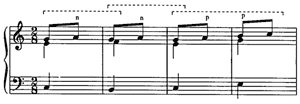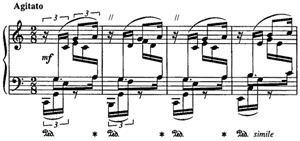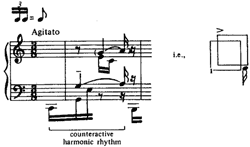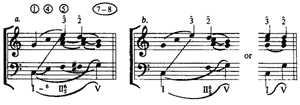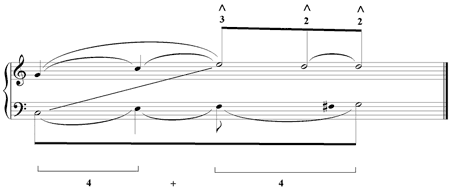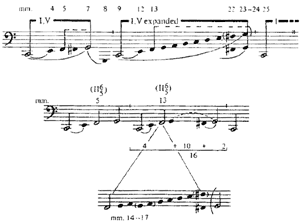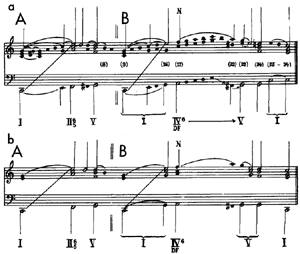Volume 13, Number 1, March 2007
Copyright � 2007 Society for Music Theory
Diane Urista*Chopin’s Prelude in C Major Revisited: Integrating Sound and Symbol |
|
ABSTRACT: This article presents comparisons of several recordings and analyses of Chopin’s Prelude in C Major, Op. 28, No. 1. My intent is to demonstrate how including recordings in the analytical process provides greater insights than those yielded by traditional analysis. The intersections and digressions between performances and written analyses are examined to reveal the relationships between the score and its sonic and symbolic interpretations.
KEYWORDS: performance, analysis, Chopin, Prelude, intersections, digressions
Received February 2007
[1.1] In this study, I explore the relationship between recorded performances and written analyses as a resource for analysis. The comparison of recordings is a tool that can influence how we approach analysis and teach our courses, a tool no less significant than those involving theoretical methodologies of form, harmony, and rhythm.(1) As the prominent theorist Joel Lester (1995) states:
Just as analysts use scores as avenues to the pieces they analyze, refer to other analyses with approbation or disapproval, they can—and should, I would argue— refer to performances in order to get at the essence of the pieces they analyze. ... The vast repertoire of recordings remains a resource barely noticed by theoretical discourse.(2)
[1.2] A close reading of the historical record supports the notion that we realize music through both sound and symbol. Perhaps, therefore, we need to reconsider our ideas about analysis and how we teach it to our students. As musicologist Nicholas Cook (2001) recently notes:
[The] most obvious way of studying music as performance is, quite simply, to study those traces or representations of past performances that make up the recorded heritage, thereby unlocking an archive of acoustical texts comparable in extent and significance to the notated texts ... (3)
[1.3] Toward this end, I use several recordings and written analyses of Chopin’s
Prelude in C Major, Op. 28, No. 1.(4) My intent is not to suggest that analysis
“corrects” performance (or vice versa); instead, I explore the intersections and
digressions between performances and analyses, an approach that provides greater
insights than traditional analysis. An intersection occurs when a performance in
some demonstrable way projects (or “supports”) an aspect of the music revealed
in an analysis. A digression, on the other hand, occurs when performances and
analyses have nothing in common, or even contradict one another.(5)
My discussion
about the integration of sound and symbol focuses initially on local levels and
is followed by an examination of large-scale events. It will be helpful to
follow the score as you listen to the recorded excerpts and examine the analyses
(see attached score: [DjVu] [GIF]).
Part I: The Opening Four Measures
Neighbors, Passing Tones, or Something Else
[2.1] We begin by comparing two different recordings of bars 1–4 of Chopin’s Prelude. The first recording is by Grigory Sokolov(6) and the second by Alicia DeLarrocha.(7) As you listen, focus on the opening G-A gestures in the upper line. Play the opening 12 measures of Sokolov (Clip #1) followed by DeLarrocha (Clip #2).
[2.2] The performances differ in their interpretations of the upper line. Sokolov projects a legato, almost seamless connection between the G-A figures, whereas DeLarrocha articulates a break after each A, creating a disjointed motion. Now consider how these performances intersect with published analyses. Examples 1a and 1b show analyses by Roger Graybill.(8) Both illustrate a motion through a fourth, from G to C (bars 1–4). In Example 1a, the first tone of the linear progression, G, is twice decorated by an upper-neighbor A before the line moves through the passing tones A and B to the goal C.
|
Example 1a. Neighbor-note motion, bars 1–2 (1994, p. 218)
(click to enlarge) |
Example 1b. Interrupted passing motion, bars 1–2 (1994, p. 218) |
In Example 1b, I use the symbol // to illustrate what Graybill writes:
I hear the upper line not as two G-A-G neighbor motions followed by a G-to-C passing motion, but rather as two ascending G-A motions �interrupted" in their upward striving to reach C, followed by a successful G-A-B-C ascent (emphasis mine).(9)
This interpretation takes into account the break between the As and following Gs, a grouping particularly well-defined because the final As are only a triplet sixteenth in duration (followed by a rest). The repeated G-As also sound as if they are starting over, making the first two G-As sound like failed attempts in their effort to attain C.
[2.3] Example 2a presents my reading, which adopts a “both/and” approach to the role of A in bars 1–2. The first and second slurs in the soprano voice indicate a two-note grouping (G-A). The eighth-note flags indicate that the As dissipate; the dotted lines, on the other hand, suggest a tenuous resolution back to the Gs. The longer slur in bars 3–4 indicates that A now functions as part of a passing motion. The As in bars 1–2, therefore, function as neighbor notes, but also embody a potential passing function that emerges as a literal passing tone in the motion of bars 3–4.
[2.4] All three analyses make assertions about the piece based on what we see in the score. Sokolov’s interpretation intersects with Example 1a, the complete neighboring motion, because he connects the A to the G of each gesture (with the aid of the damper pedal). Both Example 1a and Sokolov’s interpretation are plausible, because they represent an acceptable rendition of the notes and their respective functions.
[2.5] DeLarrocha’s interpretation is closer to Example 1b and, furthermore, is more faithful to the notation of Chopin’s score. She detaches the A from the following G of each gesture by lifting her hands and the damper pedal. The As sound clipped and the space between them and the following Gs seem at odds with the neighbor-note analysis. (The pedaling indications in the score also suggest a detached quality between the As and Gs.)(10) Further, the sixteenth note rests on the downbeat of each bar are absent in Sokolov’s interpretation, while they are articulated in DeLarrocha’s gestures. The subtle differences in articulation between these performances communicate the expressive character of the passage. In DeLarrocha’s clipped rendition, the gestures sound out of breath, urgent and agitated, corresponding to Chopin’s Agitato marking; in Sokolov’s legato rendition the gestures sound calmer, more relaxed, almost lyrical.
[2.6] A performance by Constance Keene(11)
presents a third possibility (listen to
Clip #7). In contrast to DeLarrocha’s clipping of the As, which suggests the
interrupted-passing gestures, Keene’s articulation, though still detached,
continues the influence of the As over a longer span, as shown in my analysis
(Example 2a). In other words, the As in Keene’s rendition sound as if they are
moving through a larger linear progression. It is worth remembering that the
notion of a linear progression—from the German Züg—involves a sense of pulling
or drawing. The As dissipate in DeLarrocha’s performance, while Keene’s As both
descend at the surface and pull forward to C at the foreground.
[2.7] Thus far I have considered the gestures in terms of neighboring motions,
interrupted-passing tones, and as a combination, and have demonstrated how these
interpretations intersect or digress with various performances. But these terms
do not always fully capture the subtle qualities expressed in a performer’s
articulations. The repeated As in DeLarrocha’s interpretation seem to fling up
and rebound from the previous Gs, against the pull of the linear progression.(12)
Notions of neighboring or interrupted passing are possible, but less dynamic,
less inclined to consider the subtle physiological actions of the performer. Are
the As in DeLarrocha’s recording something else? The labels “neighbor” and
“passing” note are often limited in their applicability. A broader
analysis that considers recorded performances expands our understanding into dimensions that extend beyond these
general, theoretical labels.
Two additional recordings
[3.1] I now consider other aspects of Chopin’s Prelude in two additional recordings. The first is by Ivan Moravec(13) (Clip #3), which unveils an interplay left unexpressed by the previous recordings—the echo by the soprano of the primary motive in the tenor. (Example 2b shows the paths of these melodies. Example 3, from an analysis by Wallace Berry, indicates the rhythmic relationship between these strands. Both melodies conflict with the metric structure, a conflict that contributes to the sense of agitation and forward drive. As Berry explains, �The performer who stresses the initiating bass note of each measure in the interest of �clarifying� the [harmonic and metric] situation misses the point.�(14)
| Example 2b. Offset upper and inner voices | Example 3. Berry�s
rhythmic reading (1985, p. 18)
(click to enlarge) |
[3.2] The next performance, a historic recording by Ferrucio Busoni,(15) which
took place sometimes during the early 1900s, not only exaggerates the assertions
made by Berry, but it also seems foreign to Chopin’s score. Listen to
Clip #5
and consider how far a performer might reasonably depart from the composer’s
intentions.
[3.3] Busoni distorts the rhythm by bringing in the mid-bar upper-melody gesture
a bit too early. In addition, he shifts the emphasis unpredictably from the
upper line to tenor line melody throughout the performance of the piece, adding
an element of uncertainty. The starting-and-stopping effect results in a
disjointed series of motivic gestures. Was Busoni thinking of a performance
played on a stringed instrument? His erratic,
strummed-like gestures may affirm such a view. His
performance presents an interpretation far removed from
modern performance practice and certainly conveys
Chopin�s agitation.(16)
Part II: Opening Eight Measures
4 + 4 Groupings, Initial Arpeggiation or Something Else
[4.1] We now consider two recordings and analyses of bars 1–8. Listen to the performances by Sokolov (Clip #1) and Louis Lortie(17) (Clip #4). Now consider the analysis by Wallace Berry (Example 4), which shows a progression from I to V divided into two 4-bar units. He states that the Prelude’s “basic course of action . . . creates this 4 + 4 division. . . . the upper-voice melody is in place in the first 3 bars while the tonic is clearly set, and in this sense m. 1 points to m. 4, and analogously m. 5 to m. 8.”(18) As his example illustrates, Berry interprets measures 2–3 and measures 6–7 as parenthetical, a reading that underscores a 4+4 grouping of measures.
|
Example 4. Berry’s 4+4 analysis of mm 1–8 (1985, p. 20)
(click to enlarge) |
Example 5. Forte and Gilbert’s initial arpeggiation reading of mm. 1–8 (1982, p. 193) |
[4.2] Forte and Gilbert (Example 5) read an initial arpeggiation in the upper voice from G to E; their notation suggests that the goal of the motion is E in measure 5 rather than C in measure 4.(19) In other words, the C is a note “along the way,” which (in contrast to Berry’s analysis) occurs within a broader sweep from G to E; the overall motion continues through the C in m. 4 up to the E in m. 5.
[4.3] Berry’s analysis intersects with the performance by Sokolov, who highlights the 4 + 4 grouping by slightly lingering on C in m. 4 and decreasing the dynamic level before the line reaches E in m. 5. These expressions make C sound like a goal and E as a new beginning. Lortie, on the other hand, pushes through C in m. 4 and the following E without any change in tempo or dynamics until m. 6; curiously, his motion seems to push toward D as the goal of the phrase. His performance, therefore, adds a new layer of interpretation that digresses from Berry’s 4+4 analysis and Forte/Gilbert’s interpretation of an initial arpeggiation.
[4.4] The interplay of motives also defines the two-part division of the phrase. In Sokolov’s performance, the G-A motives ascend to the C and are answered by inverted E-Ds, which descend to A in m. 8. Together they form “a call and response," a gesture highlighted beautifully by Sokolov. My own analysis, similar to that by Felix Salzer, combines aspects of Berry and Forte/Gilbert. Example 6 presents a voice-leading sketch that emphasizes the motion to C both as intermediate goal and as part of a larger sweep of the initial arpeggiation (indicated by the slur from G to E).
[4.5] Consider now two other recordings, one of which intersects with my
analysis; the other highlights characteristics not discussed thus far: (DeLarrocha,
Clip #2, and Moravec,
Clip #3). The performance by DeLarrocha reflects both the
initial arpeggiation and the 4+4 metric structure; she projects a wedge of
growth and decay that peaks on E in bar 5, but still maintains a sense of the
underlying 4+4 grouping. On the other hand, Moravec also leads to the E, but his
goal is to E in the tenor voice, which carries the lead melodic line.
Part III: A Large-Scale Perspective
Essential Predominants, Highpoints, and Other Considerations
[5.1] I now focus on the entire Prelude, discussing the different ways in which two performers articulate large-scale events. The form (typical of Chopin�s Preludes) is essentially an asymmetrical period, which in this case comprises three motions: a progression from I to V in an antecedent phrase (mm. 1�8), an elaborated and expanded repetition in a consequent phrase (mm. 9�24), followed by a coda (m. 25�end). The analyses by Berry and Salzer differ in that each places the phrase expansion at a different point in the consequent phrase (Examples 7 and 8).(20)
|
Example 7. (Berry, 1985, p. 19)
(click to enlarge) |
Example 8. (Salzer, 1962, p. 279)
(click to enlarge) |
[5.2] As shown in Example 7, Berry suggests a 4 + 10 + 2 grouping for the consequent phrase and begins the structural predominant (ii6/5) in bar 13; this marks the beginning of a weak (4-bar) hypermeasure. The predominant leads to the registral highpoint in bar 21 and closing dominant in bars 23–24. Salzer’s interpretation (Example 8), on the other hand, designates the IV6 chord in bar 17 as the structural predominant, which coincides with a strong hypermeasure (bars 17–20). Compared to Berry, Salzer’s analysis divides the consequent phrase into two 8 + 8 tonal motions. Notice that the beginnings of both predominant areas coincide with Chopin’s expressive markings, a crescendo in bar 13 and a stretto in bar 17.
[5.3] Listen now to two recordings, by Ivo Pogorelich(21) (Clip #6) and by Constance Keene (Clip #7). Each emphasizes Salzer�s predominant, but in different ways.(22) Pogorelich discreetly slips into the beginning of the predominant area (bar 17) by reducing slightly the tempo and dynamic level, before reinitiating a gradual surge to the climactic highpoint in bar 21. Keene, on the other hand, pauses at the end of bar 16 and then freely realizes the score by placing the inner-voice E on the downbeat. This “revision” dramatically highlights Salzer’s reading of the predominant in a pronounced manner.
[5.4] All of the recordings I am familiar with (except for Sokolov) seem to intersect more with Salzer’s reading than Berry’s. Many begin to increase the momentum of the phrase beginning in bar 17 with a stretto and crescendo. This is a significant juncture in the piece, the place where the upper line has gathered sufficient energy to rise unencumbered from E to the climactic highpoint C in m. 21.
[5.5] As appealing as Salzer’s reading appears to be to the performers, we must
also acknowledge that Berry’s bass-line graph has something important to say.
His analysis considers that the leap in the bass (bars 21–22) highlights F![]() ,
which can be understood as a chromatic passing tone—at a deeper level—from the F
in bar 13. The structural bass F-F
,
which can be understood as a chromatic passing tone—at a deeper level—from the F
in bar 13. The structural bass F-F![]() -G is consequently an expanded version of the
bass line in the cadential motion in the antecedent phrase (bars 5–7). Berry’s
structural predominant may exemplify an analytical situations in which, as
William Rothstein puts it, “the performer needs to conceal structure, rather
than bring it out.”(23) Analysis can reveal possibilities for both performer and
analyst to consider, and both may choose to play with or against the various
interpretations.
-G is consequently an expanded version of the
bass line in the cadential motion in the antecedent phrase (bars 5–7). Berry’s
structural predominant may exemplify an analytical situations in which, as
William Rothstein puts it, “the performer needs to conceal structure, rather
than bring it out.”(23) Analysis can reveal possibilities for both performer and
analyst to consider, and both may choose to play with or against the various
interpretations.
Part IV: Conclusion
[6.1] The comparisons presented here between performative and written interpretations of Chopin’s Prelude reveal relationships between the score and its sonic and symbolic realizations. As Lawrence Rosenwald (1993) states,
[A performance moves] precisely from a consideration of various actual performances back to a fresh analysis of the piece�not the piece itself � but the piece considered as something existing in the relation between its notation and the field of its performances.(24)
[6.2] The consideration of the score and its possible realizations also illuminates the different goals of performative and written interpretations. When we shift our analytical focus from what we see in the score to what we hear in performances—the expressive, unique subtleties of a performance—we acquire insights other than those perhaps captured in a written interpretation, that is, an interpretation that may have not been as readily apparent in the analyst’s imagined performance.
[6.3] For performers, written interpretations may encourage them to consider new interpretive possibilities they had not previously realized, or a written interpretation may simply reveal compositional insights about the piece not necessarily intended to be realized in a performance. Taking performative and analytical aspects into account allows us to acknowledge what each has to offer in the analytical process.
[6.4] The integration of sound and symbol is an approach that is not so much about getting things right as it is about revealing the interpretive possibilities that lie within a musical passage. We will always make assumptions about how a piece sounds, based on what we read and see in the score; our analytical insights, however, can only be enriched through the sonic expressions revealed in the vast repertoire of recordings.
Diane J. Urista
Oberlin College Conservatory
77 W. College St.
Oberlin, OH 44074
diane.urista@oberlin.edu
References
1. This is perhaps one reason why performers are
often dissatisfied, even frustrated with analysis, suggested by their claims
that pure analysis has little to offer in terms of guiding their sonic
representation of the score.
Return to text
2. Joel Lester, “Performance and Analysis: Interaction and
Interpretation,” in The Practice of Performance: Studies in Musical
Interpretation, ed. John Rink (Cambridge: University Press, 1995), 197–216.
Return to text
3. Nicholas Cook, “Between Process and Product: Music and/as Performance,”
Music
Theory Online 7/2 (2001), 21.
Return to text
4.
This article is an outgrowth of a paper I gave at the New York State Music
Theory Society annual meeting, 2002, at Barnard College. My own analyses evolved
out of the process of comparing performances, and the feedback I received from
several who attended the session. I would especially like to thank Christopher
Hasty and the late Jonathan Kramer for their insights.
Return to text
5. Several of the analyses considered for this study use Schenkerian techniques.
This is by no means a bias on the author’s part, but rather one of circumstance,
given that most published analyses of this piece are Schenkerian. Examining the
intersections and digressions between recordings and other types of analytical
methodologies would be interesting to consider. Such an examination, however,
extends beyond the scope of this paper and would be better served in subsequent
studies.
Return to text
6.
Clip #1—Chopin, F. (1990). Prelude in C Major, Op. 28, No. 1. Recorded by Grigory Sokolov. On
Preludes, Op. 28 [CD]. Paris, France: Opus Productions. OPS
30-9006.
Return to text
7. Clip #2—Chopin, F. (1970). Prelude in C Major, Op. 28, No. 1. Recorded by
Alicia DeLarrocha. On Twenty-Four Preludes [CD]. London, England: London.
433089-2.
Return to text
8. Roger Graybill, “Prolongation, Gesture, and Musical Motion,” in
Musical
Transformation and Musical Intuition: Essays in Honor of David Lewin, eds.
Raphael Atlas and Michael Cherlin (Massachusetts: Ovenbird Press, 1994),
199–224. p. 218.
Return to text
9. Ibid., p. 218.
Return to text
10. Many of the performance treatises written about this piece suggest that the
performer lift the pedal after the As to create a breath. See, Eleanor Bailie,
The Pianist’s Repertoire, Chopin: A Graded Practical Guide (London: Kahn &
Averill, 1998); Alfred Cortot, Alfred Cortot’s Studies on Musical Interpretation
(London: George G. Harrap & Co, 1937); Jean-Jacques Eigeldinger, “Twenty-four
Preludes op. 28: genre, structure, significance,” in Chopin Studies (Cambridge:
Cambridge University Press, 1988), 167–193; and Jeffrey Kresky, A Reader’s
Guide to the Chopin Preludes (London: Greenwood Press, 1994).
Return to text
11. Clip #7—Chopin, F. (1988). Prelude in C Major, Op. 28, No. 1. Recorded by
Constance Keene. On Chopin and Mendelssohn [CD]. Los Angeles, CA: Protone
Records. 1105.
Return to text
12. I would like to thank musicologist, Janet Levy, for discussing DeLarrocha’s
performance with me, which helped me think outside of some of my own theoretical
boxes.
Return to text
13. Clip #3—Chopin, F. (1976). Prelude in C Major, Op. 28, No. 1. Recorded by
Ivan Moravec. On Twenty-four Preludes [CD]. Czechoslovakia: Supraphon. 110630.
Return to text
14. Wallace Berry, “Metric and Rhythmic Articulation in Music,”
Music Theory
Spectrum 7 (1985): 7–33, p. 18.
Return to text
15. Clip #5—Chopin, F. (1990). Prelude in C Major, Op. 28, No. 1. Recorded by Ferrucio Busoni. On
Instruments of the Past: The Reproducing Piano [CD]. Italy: Fonè. Recorded from piano rolls originally published 1915–1925.
Return to text
16. Eigeldinger speculates that Chopin’s Prelude is perhaps a stylized version of
the French 17th C ‘brise’ style of lute writing. Eigeldinger, Chopin Studies,
175.
Return to text
17. Clip #4—Chopin, F. (1998). Prelude in C Major, Op. 28, No. 1. Recorded by
Louis Lortie. On Twenty-four Preludes [CD]. Colchester, Essex, England: Chandos.
9597.
Return to text
18. Wallace Berry, “Metric and Rhythmic Articulation in Music,” 1985, 20.
Return to text
19. Forte, Allen and Steven E. Gilbert, Introduction to Schenkerian Analysis (New
York: W.W. Norton and Co., 1982), 193.
Return to text
20. Berry, “Metric and Rhythmic Articulation in Music,” 19; Salzer, Felix.
Structural Hearing (New York: Dover Publications, 1962), 279.
Return to text
21. Clip #6—Chopin, F. (1990). Prelude in C Major, Op. 28, No. 1. Recorded by Ivo
Popgorelich. On Preludes [CD]. Hamburg: Deutsche Grammaphon. 429227-2.
Return to text
22. In Pogorelich’s performance, also note how beautifully he inscribes onto our
ears the two-note G-A, E-D motive in mm. 25 through 28—a summarized version of
the thrice stated G-As in mm. 1–3 and E-Ds in mm. 5–7.
Return to text
23. William Rothstein, “Analysis and the Act of Performance,” in
The Practice of
Performance: Studies in Musical Interpretation, ed. John Rink (Cambridge:
University Press, 1995), 229.
Return to text
24. Lawrence Rosenwald, “Theory, Text-Setting, and Performance,”
Journal of
Musicology 11 (1993), 62.
Return to text
Copyright Statement
Copyright � 2007 by the Society for Music Theory. All rights reserved.
[1] Copyrights for individual items published in Music Theory Online (MTO) are held by their authors. Items appearing in MTO may be saved and stored in electronic or paper form, and may be shared among individuals for purposes of scholarly research or discussion, but may not be republished in any form, electronic or print, without prior, written permission from the author(s), and advance notification of the editors of MTO.
[2] Any redistributed form of items published in MTO must include the following information in a form appropriate to the medium in which the items are to appear:
This item appeared in Music Theory Online in [VOLUME #, ISSUE #] on [DAY/MONTH/YEAR]. It was authored by [FULL NAME, EMAIL ADDRESS], with whose written permission it is reprinted here.
[3] Libraries may archive issues of MTO in electronic or paper form for public access so long as each issue is stored in its entirety, and no access fee is charged. Exceptions to these requirements must be approved in writing by the editors of MTO, who will act in accordance with the decisions of the Society for Music Theory.
This document and all portions thereof are protected by U.S. and international copyright laws. Material contained herein may be copied and/or distributed for research purposes only.
Prepared by Brent Yorgason, Managing Editor
Updated
31 March 2007

